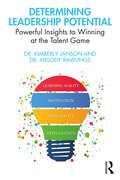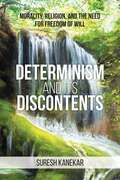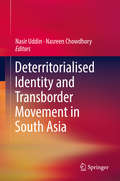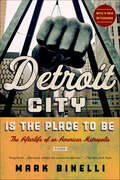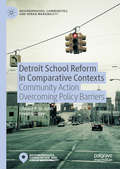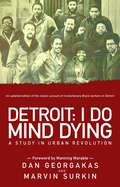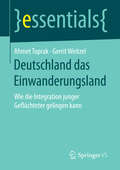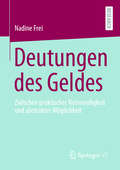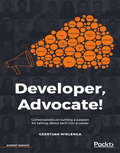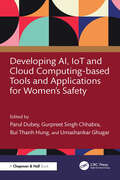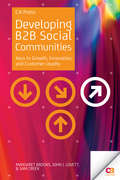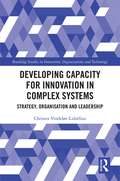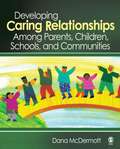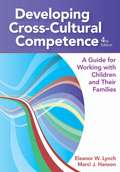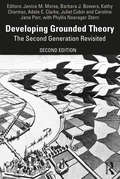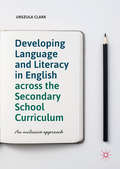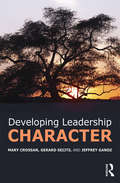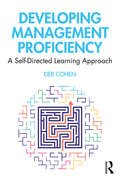- Table View
- List View
Determinanten der Schulwahl
by Peter SuterPrivatschulen sind sowohl in Politik und den Medien als auch bei Lehrpersonen und Eltern immer wieder Gegenstand heftiger Diskussionen. Dennoch gibt es zu diesem Thema kaum empirische Forschungen. Peter Suter analysiert in der Schweiz Motive und Hintergründe, die Eltern dazu veranlassen ihr Kind auf eine private Primarschule zu schicken. Er zeigt, dass die Qualität und das Leistungsniveau der Schule für die Wahl sekundär ist - obwohl diese Aspekte als die zentralen Gütekriterien einer guten Schule genannt werden. Eltern, die sich für eine Privatschule entscheiden, sind meist Expatriate mit hohem sozioökonomischen Status, die sich vorwiegend für eine zweisprachige Ausbildung und ein umfassendes Betreuungsangebot interessieren. Insgesamt belegen die Resultate, dass die Schulwahl in erster Linie habituell geleitet und nicht das Resultat einer rationalen Entscheidung ist.
Determining Leadership Potential: Powerful Insights to Winning at the Talent Game
by Kimberly Janson Melody RawlingsWe are in the midst of a leadership crisis that is derailing business success, and it’s time to get rigorous about talent. This book will show you how, with an effective and consistent framework, to help galvanize decision-makers around leadership potential. Time and time again, organizations place too many leaders in roles they are not a good fit for. The financial, strategic, and human costs of poor leadership are staggering and unnecessary. But organizations that effectively identify high-potential talent are likely to financially outperform those that do not do this work by a factor of 4.2 to 1, not to mention all the other positive impacts. Backed by the authors’ research, including a study with 50+ global CEOs, the insights and strategies packed into this book will help you eliminate the shocking variation that exists in how people think about determining leadership potential – and empower decision-makers to be game-changers to optimize their organizations. For too long, leadership potential has been treated as an imprecise art and inconsistently applied. CEOs, board members, senior managers, and HR professionals will welcome the thought-provoking insights and practical tools this book gives to build a pipeline of strong leaders.
Determining Leadership Potential: Powerful Insights to Winning at the Talent Game
by Kimberly Janson Melody RawlingsWe are in the midst of a leadership crisis that is derailing business success, and it’s time to get rigorous about talent. This book will show you how, with an effective and consistent framework, to help galvanize decision-makers around leadership potential.Time and time again, organizations place too many leaders in roles they are not a good fit for. The financial, strategic, and human costs of poor leadership are staggering and unnecessary. But organizations that effectively identify high-potential talent are likely to financially outperform those that do not do this work by a factor of 4.2 to 1, not to mention all the other positive impacts. Backed by the authors’ research, including a study with 50+ global CEOs, the insights and strategies packed into this book will help you eliminate the shocking variation that exists in how people think about determining leadership potential – and empower decision-makers to be game-changers to optimize their organizations.For too long, leadership potential has been treated as an imprecise art and inconsistently applied. CEOs, board members, senior managers, and HR professionals will welcome the thought-provoking insights and practical tools this book gives to build a pipeline of strong leaders.
Determining Sample Size and Power in Research Studies: A Manual for Researchers
by J. P. Verma Priyam VermaThis book addresses sample size and power in the context of research, offering valuable insights for graduate and doctoral students as well as researchers in any discipline where data is generated to investigate research questions. It explains how to enhance the authenticity of research by estimating the sample size and reporting the power of the tests used. Further, it discusses the issue of sample size determination in survey studies as well as in hypothesis testing experiments so that readers can grasp the concept of statistical errors, minimum detectable difference, effect size, one-tail and two-tail tests and the power of the test. The book also highlights the importance of fixing these boundary conditions in enhancing the authenticity of research findings and improving the chances of research papers being accepted by respected journals. Further, it explores the significance of sample size by showing the power achieved in selected doctoral studies. Procedure has been discussed to fix power in the hypothesis testing experiment. One should usually have power at least 0.8 in the study because having power less than this will have the issue of practical significance of findings. If the power in any study is less than 0.5 then it would be better to test the hypothesis by tossing a coin instead of organizing the experiment. It also discusses determining sample size and power using the freeware G*Power software, based on twenty-one examples using different analyses, like t-test, parametric and non-parametric correlations, multivariate regression, logistic regression, independent and repeated measures ANOVA, mixed design, MANOVA and chi-square.
Determinism and Its Discontents: Morality, Religion, and the Need for Freedom of Will
by Suresh V. KanekarThe deterministic position is that all events are effects of previous events and causes of future events, in inexorable cause-effect sequences, which leave no room for intervention of anything outside of the stream of causal relationships, such as free wi
Deterritorialised Identity and Transborder Movement in South Asia
by Nasreen Chowdhory Nasir UddinThis volume is about migration across South Asia and the complex negotiation of borders by people and the states in the process. A border is understood as a form of demarcation, but it also opens up the flow of people, goods, and ideas of legality and illegality. Borders are dynamic and dyadic in the interface of state and non-state actors involved in border operations. Consequently, transborder movement becomes a complex web involving concerns of security, trade, militancy, and questions of citizenship, along with discourses of ghettoisation, belonging and otherness. Since the mid-20th century, the South Asian region has witnessed growing social and political instability and breakdown of regional cooperation. In this context, the volume casts a wide, interdisciplinary lens across South Asia and discusses economic migration as well as forced migration due to persecution and natural disasters. It looks at how understandings of ‘territoriality’ and ‘border’ become blurred due to increasing transborder migration in the region: how states in South Asia address transborder movements at both policy level and on the ground; and how borderlands become spaces for illegal trade and informal economy in South Asia and for negotiations between states and refugees on identity and citizenship. This highly topical volume is for a wide group of scholars and students interested in South Asia, ranging from sociology, anthropology, political science, history, to interdisciplinary fields like migration studies, peace and conflict studies, and development studies.
Detroit City Is the Place to Be: The Afterlife of an American Metropolis
by Mark BinelliDetroit City Is the Place to Be is one of Publishers Weekly's Top 10 Best Books of 2012. Once America's capitalist dream town, Detroit is our country's greatest urban failure, having fallen the longest and the farthest--and, finally, into the largest municipal bankruptcy in U.S. history. Binelli does not shy away from exploring the violence, economic devastation, political corruption, and physical ruin that have ravaged his hometown, but he also offers a glimpse of a long-shot future: Detroit that is smaller, less segregated, greener, economically diverse, and better functioning--what could be the boldest reimagining of a postindustrial city in our new century.
Detroit City Is the Place to Be: The Afterlife of an American Metropolis
by Mark BinelliOnce America's capitalist dream town, Detroit is our country's greatest urban failure, having fallen the longest and the farthest. But the city's worst crisis yet (and that's saying something) has managed to do the unthinkable: turn the end of days into a laboratory for the future. Urban planners, land speculators, neopastoral agriculturalists, and utopian environmentalists—all have been drawn to Detroit's baroquely decaying, nothing-left-to-lose frontier.With an eye for both the darkly absurd and the radically new, Detroit-area native Mark Binelli has chronicled this convergence. Throughout the city's "museum of neglect"—its swaths of abandoned buildings, its miles of urban prairie—he tracks both the blight and the signs of its repurposing, from the school for pregnant teenagers to a beleaguered UAW local; from metal scrappers and gun-toting vigilantes to artists reclaiming abandoned auto factories; from the organic farming on empty lots to GM's risky wager on the Volt electric car; from firefighters forced by budget cuts to sleep in tents to the mayor's realignment plan (the most ambitious on record) to move residents of half-empty neighborhoods into a viable, new urban center.Sharp and impassioned, Detroit City Is the Place to Be is alive with the sense of possibility that comes when a city hits rock bottom. Beyond the usual portrait of crime, poverty, and ruin, we glimpse a longshot future Detroit that is smaller, less segregated, greener, economically diverse, and better functioning—what could be the boldest reimagining of a post-industrial city in our new century. Detroit City Is the Place to Be is one of Publishers Weekly's Top 10 Best Books of 2012
Detroit School Reform in Comparative Contexts: Community Action Overcoming Policy Barriers (Neighborhoods, Communities, and Urban Marginality)
by Edward St. John feven girmayThis book critically examines how the narrative of global economic competition was used to rationalize college preparatory curriculum for all high school students and promote charter schools in Detroit. Using mixed qualitative and quantitative methods, the study identifies neighborhood risk factors undermining students’ academic success, along with the positive effects of churches and service centers as mitigating forces. The authors focus on a range of topics and issues including market competition, urban decline, community resources, testing and accountability, smaller schools, and engaged learning. The volume illustrates how action studies by engaged scholars working with community activists empowers students to overcome emerging barriers.
Detroit: A Biography
by Scott MartelleAt its heyday in the 1950s and 1960s, Detroit's status as epicenter of the American auto industry made it a vibrant, populous, commercial hub--and then the bottom fell out. Detroit: A Biography takes a long, unflinching look at the evolution of one of America's great cities and one of the nation's greatest urban failures. This authoritative yet accessible narrative seeks to explain how the city grew to become the heart of American industry and how its utter collapse--from nearly two million residents in 1950 to less than 715,000 some six decades later--resulted from a confluence of public policies, private industry decisions, and deeply ingrained racism. Drawing from U.S. Census data and including profiles of individuals who embody the recent struggles and hopes of the city, this book chronicles the evolution of what a modern city once was and what it has become.
Detroit: A Study in Urban Revolution
by Marvin Surkin Dan GeorgakasDetroit: I Do Mind Dying tracks the extraordinary development of the Dodge Revolutionary Union Movement and the League of Revolutionary Black Workers as they became two of the landmark political organizations of the 1960s and 1970s. It is widely heralded as one the most important books on the black liberation movement. Marvin Surkin received his PhD in political science from New York University and is a specialist in comparative urban politics and social change. He worked at the center of the League of Revolutionary Black Workers in Detroit. Dan Georgakas is a writer, historian, and activist with a long-time interest in social movements. He is the author of My Detroit, Growing up Greek and American in Motor City.
Deutschland das Einwanderungsland: Wie die Integration junger Geflüchteter gelingen kann (essentials)
by Ahmet Toprak Gerrit WeitzelDieses essential befasst sich mit der Situation junger Gefl#65533;chteter in der Bundesrepublik Deutschland. Neben den Gr#65533;nden, warum Menschen fliehen und ihre Heimat verlassen, stehen im Zentrum dieses essentials die Fragen, was Integration politisch und gesellschaftlich im Kontext der Arbeitsmigration bedeutet hat, was Integration im wissenschaftlichen und im praktischen Sinne bedeutet und wie daraus ableitend die Integration der jungen Gefl#65533;chteten anno 2016 gelingen kann.
Deutschsprachige Psychologinnen und Psychologen 1933-1945
by Uwe Wolfradt Elfriede Billmann-Mahecha Armin StockMehr als 300 Kurzbiographien mit Werkbezug geben über 80 Jahre nach der Machtübernahme durch die Nationalsozialisten Aufschluss über Psychologinnen und Psychologen, die von dem damaligen politischen und gesellschaftlichen Wandel betroffen waren. Einige wurden aufgrund ihrer Herkunft oder politischen Überzeugung in die Emigration gezwungen und mussten unter schwierigsten Bedingungen in der Fremde ein neues Leben aufbauen. Akademische Lebenswege wurden abgeschnitten oder konnten nur unter erschwerten Umständen weitergeführt werden. Andere Psychologinnen und Psychologen blieben in Deutschland und versuchten, sich auf unterschiedliche Weise mit den neuen politischen Verhältnissen zu arrangieren. Darunter waren auch Einzelne, die durch den Eintritt in eine NS-Organisation oder in die NSDAP ihre persönliche Karriere zu fördern suchten.
Deutungen des Geldes: Zwischen praktischer Notwendigkeit und abstrakter Möglichkeit
by Nadine FreiDie soziologische Studie leistet einen Beitrag zum Verständnis der Ambivalenz und der gesellschaftlichen Legitimität des Geldes. Die Untersuchung beinhaltet eine theoretische Diskussion aktueller Geldtheorien mit Rückgriff auf Georg Simmel sowie eine empirische Analyse von alltagsweltlichen Vorstellungen von Geld. Es wird gezeigt, dass Geld als Mittel der Rationalisierung einen zweckrationalen Zugang zur Welt verschafft. Zugleich erlaubt es als Mittel der Romantisierung eine Distanzierung zur Gesellschaft. Die theoretische und empirische Rekonstruktion der Deutungen von Geld hebt sich von Ansätzen ab, die Geld ausschließlich im Hinblick auf dessen Verknüpfung mit der Rationalisierung problematisieren.Die Autorin Nach dem Studium der Soziologie in Bern arbeitete Nadine Frei an den Universitäten Hildesheim und Halle. Sie promovierte im Fachbereich Soziologie an der Martin-Luther-Universität Halle-Wittenberg.
Developer, Advocate!: Conversations on turning a passion for talking about tech into a career
by Geertjan WielengaA collection of in-depth conversations with leading developer advocates that reveal the world of developer relations today Key Features Top developer advocates reveal the work they're doing at the center of their tech communities and the impact their advocacy is having on the tech industry as a whole Discover the best practices of developer advocacy and get the inside story on working at some of the world's largest tech companies Features contributions from noted developer advocates, including Scott Hanselman, Sally Eaves, Venkat Subramaniam, Jono Bacon, Ted Neward, and more Book Description What exactly is a developer advocate, and how do they connect developers and companies around the world? Why is the area of developer relations set to explode? Can anybody with a passion for tech become a developer advocate? What are the keys to success on a global scale? How does a developer advocate maintain authenticity when balancing the needs of their company and their tech community? What are the hot topics in areas including Java, JavaScript, "tech for good," artificial intelligence, blockchain, the cloud, and open source? These are just a few of the questions addressed by developer advocate and author Geertjan Wielenga in Developer, Advocate!. 32 of the industry's most prominent developer advocates, from companies including Oracle, Microsoft, Google, and Amazon, open up about what it's like to turn a lifelong passion for knowledge sharing about tech into a rewarding career. These advocates run the gamut from working at large software vendors to small start-ups, along with independent developer advocates who work within organizations or for themselves. In Developer, Advocate!, readers will see how developer advocates are actively changing the world, not only for developers, but for individuals and companies navigating the fast-changing tech landscape. More importantly, Developer, Advocate! serves as a rallying cry to inspire and motivate tech enthusiasts and burgeoning developer advocates to get started and take their first steps within their tech community. What you will learn Discover how developer advocates are putting developer interests at the heart of the software industry in companies including Microsoft and Google Gain the confidence to use your voice in the tech community Immerse yourself in developer advocacy techniques Understand and overcome the challenges and obstacles facing developer advocates today Hear predictions from the people at the cutting edge of tech Explore your career options in developer advocacy Who this book is for Anybody interested in developer advocacy, the impact it is having, and how to build developer advocacy capabilities
Developing AI, IoT and Cloud Computing-based Tools and Applications for Women’s Safety
by Bui Thanh Hung Parul Dubey Gurpreet Singh Chhabra Umashankar GhugarIn a world increasingly driven by technology, this book explores the intersection of artificial intelligence (AI), IoT, and Cloud Computing and women's safety, highlighting the transformative potential of technology in safeguarding women's well-being in the physical and the digital world. As the safety and security industry embraces technological advancements, the need for inclusive and gender-centric solutions has become increasingly evident. This reference book delves into this critical area, showcasing the development of AI, IoT, and Cloud applications specifically tailored to address the unique safety challenges faced by women.• Provides a comprehensive exploration of how AI and related technologies are reshaping the future of women's safety.• Emphases the utilisation of AI to tackle the specific challenges women encounter in various contexts.• Introduces innovative solutions such as wearable technology, AI-powered surveillance systems, and mobile applications designed for emergency responses.• Discusses ethical implications of deploying technology for personal security and navigates the evolving legal landscape surrounding data privacy.• Bridges the gap between theoretical discussions and practical implementations, offering a guide to developing technology for the improvement of women's safety.It is an invaluable resource for professionals and researchers interested in the transformative role of AI, IoT, and Cloud in shaping the future of women's safety.
Developing B2B Social Communities
by Margaret Brooks J. J. Lovett Sam CreekDeveloping B2B Social Communities: Keys to Growth, Innovation, and Customer Loyalty explains why business-to-business companies need a robust online community strategy to survive and flourish in today's changing economy and shows you how to design and execute your company's strategy successfully. Seminars, publications, market research, and customer care centers remain important tools in every B2B firm's toolbox for understanding, attracting, and serving customers while keeping them loyal. But in a world of fierce global price competition, increasing transparency of business practices, and ever-rising complexity, these traditional customer interaction channels are no longer enough for most B2B companies. That's why smart organizations--both large and small--are tapping into online communities to gain a huge competitive advantage: the ability to get much closer to customers and become more valuable to them. Developing B2B Social Communities delves into the generators of business value in online communities: immediate customer access to expert information within the company and from other customers; inexpensive delivery of custom technical help; demonstrations of how customers can to get the most from their products; and forums where customers can share tips, air gripes, reveal unmet needs, and suggest improvements. Three veteran community managers show you how to harness the knowledge of the crowd to help shape your company's strategic direction, develop new products and services, identify trends, sell more, serve customers more efficiently, and provide better product support. Fleshing out precepts with real-world examples and case studies, the authors detail the transformational opportunities--and pitfalls--for creating online communities. What you'll learn Why B2B companies of all sizes now need to make online communities an integral part of their operations to maintain or expand market share. How to create, launch, and manage customer communities. How to integrate communities into the business processes of an organization so they have the greatest impact. How to create clear strategies for the social community that support larger business goals. How to define and measure what you gain from hosting online communities. How to develop operational best practices that will provide the greatest ROI. Who this book is for This book is for all professionals in B2B organizations who are charged to improve customer service and loyalty, engage in ongoing research and collaboration with customers, increase sales, identify new product ideas, promote product utilization, provide superior customer service, or monitor industry trends. Readers who will benefit from Developing B2B Social Communities include community managers, C-level decision makers, strategy professionals, marketing directors and executives, customer care professionals, senior technology leaders, and actual and prospective community leaders. Table of Contents The Human Need to Connect Community as the Centerpiece of B2B Engagement Community Models Life Cycle and Maturity Models for Online Communities Community Management Case Study in Focus: CA Technologies Business Impact Through Community Developing B2B Social Communities
Developing Capacity for Innovation in Complex Systems: Strategy, Organisation and Leadership (Routledge Studies in Innovation, Organizations and Technology)
by Christer Vindeløv-LidzéliusBased on a theoretical analysis and supported by both explorative qualitative and quantitative research, this book examines the many reasons why an initiative becomes an innovation and why some organizations are better at innovation than others. Developing Capacity for Innovation in Complex Systems offers insights into the history of the idea of innovation, as well as knowledge around different discourses on innovation. The purpose of this book is to help organisations further their aspirations and work with innovation. It is based on three premises: (1) that capacity can be developed, (2) that it is worthwhile trying to do so, and (3) there are however no guarantees for success. Providing a comprehensive view of innovation and discussing the theoretical challenges, the book contributes towards a holistic theory for capacity building for innovation. The book conveys frameworks, methodologies, and tools that are used in terms of innovation, and it explains positive strategies for innovation that are being developed. Complexity theory is presented and attributed to the construct of innovation to further the understanding of the intricacies and fallacies of innovation work. This book will be of direct interest to scholars and subject matter experts in the field of innovation management. Business leaders and reflective practitioners will find the content relevant and accessible.
Developing Caring Relationships among Parents, Children, Schools, and Communities
by Dana R. McdermottThis book focuses on parents and teachers as adult learners, who should be growing and learning along with the children in their care. It lays out a theory of what parents and teachers need to care for children and themselves and then it shows how the author has assisted parents and teachers to put these theories into practice. McDermott relies on stories and listening to the voices of parents, teachers and children to make her case. She weaves together the latest theories and research with these stories. She uses narratives of actual school meetings, workshops, parent planning and discussion groups, testimonies, newsletters, and research of others in the field, to demonstrate applications of theory and research. She fills a gap by focusing on parents from all socioeconomic backgrounds. Key Features: o Focuses on parents and teachers as adult learners o Focuses on the dynamic process of parenting and teaching o Provides a theory to practice model to support parents, families and teachers o Provides a tool or guide for thinking through problems and finding solutions that take into consideration the needs of all involved.
Developing Clinical Skills for Substance Abuse Counseling
by Daniel YalisoveThis skill-building primer provides a framework for understanding substance abuse and teaches the basic concepts and skills necessary for effective counseling of clients with substance use disorders.
Developing Cross-cultural Competence: A Guide For Working With Children And Their Families, Fourth Edition
by Deborah Chen Eleanor W. Lynch Marci J. Hanson<P><P>As the U.S. population grows more and more diverse, how can professionals who work with young children and families deliver the best services while honoring different customs, beliefs, and values? The answers are in the fourth edition of this bestselling textbook, fully revised to reflect nearly a decade of population changes and best practices in culturally competent service delivery. <P><P> The gold-standard text on cross-cultural competence, this book has been widely adopted by college faculty and trusted as a reference by in-service practitioners for almost 20 years. For this timely NEW edition, the highly regarded authors have carefully updated and expanded every chapter while retaining the basic approach and structure that made the previous editions so popular. Professionals will <P><P> Get a primer on cultural competence. Readers will examine how their own cultural values and beliefs shape their professional practice, how the worldviews of diverse families may affect their perceptions of programs and services, and how providers can communicate more effectively with families from different cultural backgrounds. Deepen their understanding of cultural groups. Learn from in-depth chapters with nuanced, multifaceted explorations of nine different cultural backgrounds: Anglo-European, American Indian, African American, Latino, Asian, Filipino, Native Hawaiian and Samoan, Middle Eastern, and South Asian. Readers will get up-to-date insights on history, demographics, traditions, values, and family structure, and they'll examine the diverse ways each culture approaches child rearing, medical care, education, and disability. Discover better ways to serve families. Readers will get concrete recommendations for providing more effective, sensitive, and culturally competent services to children and families. They'll find practical guidance for every step in the service delivery process, from initiating contact with families to implementing and evaluating services. Vivid case stories and photos bring the principles of cultural competence to life, and the helpful appendixes give professionals quick access to cultural courtesies and customs, key vocabulary words, significant cultural events and holidays, and more. Plus an expanded list of resources points readers to books, films, theater, and other media that will enhance their understanding of other cultures. New to this edition is a revised chapter on African American roots; thoroughly updated and expanded chapters; expanded coverage of disabilities; more on spiritual and religious diversity; and strategies for helping families make decisions about language use (English-only vs. preservation of native language). <P><P> Equally valuable as a textbook and a reference for practicing professionals, this comprehensive book will prepare early interventionists and other professionals to work effectively with families whose customs, beliefs, and values may differ from their own.
Developing Grounded Theory: The Second Generation Revisited (Developing Qualitative Inquiry)
by Juliet Corbin Kathy Charmaz Adele E. Clarke Janice M. Morse Phyllis Noerager Stern Caroline Jane Porr Barbara J. BowersDeveloping Grounded Theory: The Second Generation Revisited is a highly accessible description of the rapid development of grounded theories and the latest developments in grounded theory methods.A succinct overview of the development of grounded theory is provided, including the similarities and differences between Glaserian and Straussian grounded theory. The method introduced by Schatzman, and the development of Charmaz’s constructivist grounded theory and Clarke’s situational analysis, are clearly presented. The book is divided into seven sections: each type of grounded theory is discussed by the developer (or their student), followed by a chapter describing a project that used that particular type of grounded theory. Bookending these chapters is the first chapter, which describes the development and landscape of grounded theory, and a final chapter describing the challenges to the future of grounded theory. This book is ideally suited for beginning students trying to come to grips with the field as well as more advanced researchers attempting to delineate the major types of grounded theory.
Developing Language and Literacy in English across the Secondary School Curriculum: An Inclusive Approach
by Urszula ClarkThis book draws on original research and a language based pedagogy approach to examine how secondary schools in the UK can devise and implement coherent language and literacy across curriculum policies and strategies, so that grammar and associated metalanguage becomes an integral part of their day to day curriculum practices. The research was undertaken in three 11 to 18 secondary schools in England, where the majority of students are categorised as having English as a second language (EAL), and where a significant minority are also socially disadvantaged in two of the three. The author argues that paying explicit attention to the linguistic structures through which subject knowledge is realised can be of benefit to all pupils in ways that are also socially just and democratic. This book provides an important bridge between academic theory and educational practice that will appeal to applied linguists and sociolinguists, as well as to teachers, teacher trainers and practitioners.
Developing Leadership Character
by Gerard Seijts Mary Crossan Jeffrey GandzThis book focuses on the element of leadership that has largely been neglected in the literature: character. Often thought to be a subjective construct, the book demonstrates the concrete behaviors associated with different character dimensions in order to illustrate how these behaviors can be developed, and character strengthened. Based on research involving over 300 senior leaders from different industries, sectors and countries, Crossan, Seijts, and Gandz developed a model for leadership character that focuses on eleven dimensions. The book begins by setting the context for the focus on character in business, asking what character is and whether it can be learned, developed, molded or changed. Next, the book focuses on each dimension of leadership character in turn, exploring its elements and the ways in which it can be applied in a business setting. The book concludes with a summary of the key insights, an exploration of the interactions between the character dimensions, and a call to the reader to reflect on how to develop one’s own and others’ leadership character. Bridging theory and management practice, Developing Leadership Character will interest students and practitioners alike. Readers will benefit not only from a new, robust theoretical framework for leadership character, but will also learn how character can be developed further.
Developing Managerial Proficiency: A Self-Directed Learning Approach
by Deb CohenDeveloping Management Proficiency: A Self-Directed Learning Approach is a pragmatic, easy-to-follow roadmap for managers to help develop the behaviors and skills necessary for success. Strong behavioral competencies are essential for any manager today. Emphasizing a self-directed learning approach, this book is designed to transform passive learners into active learners by helping to develop behavioral skills, based on individual needs. By providing the reader with the tools for self-directed learning, Deb Cohen provides an unending mechanism to learn, improve, and grow, helping develop the proficiencies needed to be successful in doing their job or advancing in their career. With features such as practical examples, worksheets, tables, and figures, the book is packed full of self-directed learning activities including role play, observation, networking, journaling, and questioning, all powerful drivers of learning and development. With expert guidance on how to approach personal development in day-to-day activities rather than in a formal course setting, this book is an essential resource for managers at all levels, as well as anyone training or interested in a managerial role.

